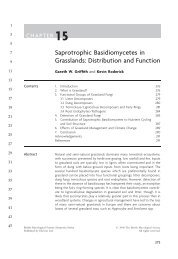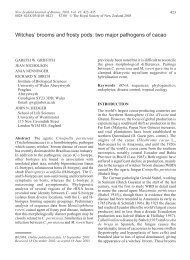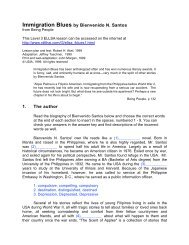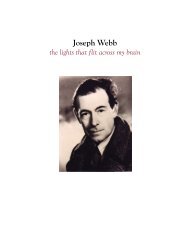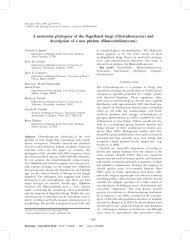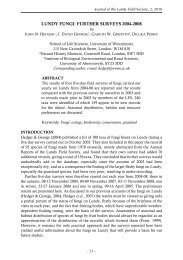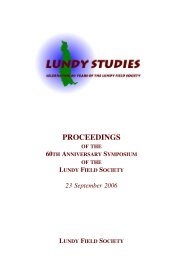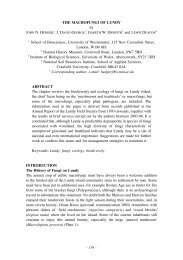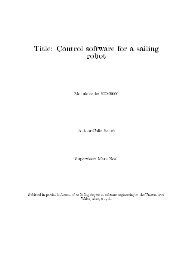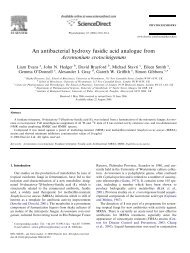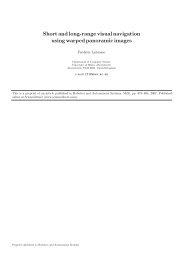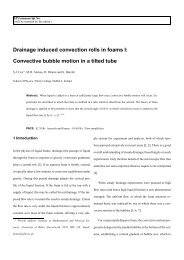Anaerobic rumen fungi
Anaerobic rumen fungi
Anaerobic rumen fungi
You also want an ePaper? Increase the reach of your titles
YUMPU automatically turns print PDFs into web optimized ePapers that Google loves.
Agriculturally Important Microorganisms Vol. II<br />
Brookman et al., 2000b). In the latter case, <strong>fungi</strong> could be resuscitated from pure cultures after<br />
incubation at 39ºC for up to 11 months (anaerobic <strong>fungi</strong>, however, do not survive beyond 10 days<br />
without subculturing) (Ozkose, 2001). Furthermore, thick-walled, elongate and septate spores<br />
are readily visible in these cultures. The ability of anaerobic <strong>fungi</strong> to form spores and possibly,<br />
other resting structures in large part explain why they can be transferred so readily between host<br />
animals, and far more easily than <strong>rumen</strong> protozoans which require direct animal contact<br />
(Williams, 1986). In fact, during an early study on <strong>rumen</strong> protozoans, Becker and Hsiung (1929)<br />
prevented re-infection by "Callimastix" [sic] of isolated defaunated goats for more than a few<br />
weeks (even if the feed was sterilized). As is the case with <strong>rumen</strong> protozoans, transfer of<br />
anaerobic <strong>fungi</strong> from mother to neonates can also occur by direct contact with saliva during<br />
grooming and licking, or by coprophagy (Lowe et al. 1987b; Milne et al. 1989). In sheep, anaerobic<br />
fungal populations are established by 8-10 days of birth (Fonty et al. 1987). As ruminal <strong>fungi</strong> can<br />
utilize lactose as a carbon and energy source, their population, along with other microorganisms,<br />
gets accumulated and develops in the under developed <strong>rumen</strong> of young lambs fed on milk; and<br />
subsequently stabilizes with the development of <strong>rumen</strong> as the animal starts consuming fibrous<br />
diet (Fonty et al. 1987; Fonty and Grenet, 1994).<br />
Fungal transfer in nature is not only inter-ruminant, but also from non-ruminant to ruminant<br />
as these can also be transmitted by aerosols and dried faeces (Orpin, 1989; Dehority and Orpin,<br />
1996). Interspecies transfer has been demonstrated by the establishment in sheep of high ruminal<br />
populations of Piromyces sp. isolated from horse faeces and also a strain of Neocallimastix from the<br />
reindeer <strong>rumen</strong> (Orpin, 1989). Orpinomyces sp. and Piromyces sp., from cow's <strong>rumen</strong> and faeces of<br />
wild blue bull, respectively, establish in the <strong>rumen</strong> after administrating to male buffalo calves fed<br />
with wheat straw based diets (Tripathi et al. 2007b). As with the <strong>rumen</strong> protozoans, where<br />
evidence of host specificity is equivocal (Williams, 1986), the various anaerobic fungal taxa show<br />
little geographic structure with diet having a far greater effect on fungal population than the host.<br />
However, Phillips and Gordon (1988) reported that polycentric taxa could not be isolated from<br />
sheep in Australia.<br />
8. FIBRE DEGRADATION POTENTIAL<br />
The role of <strong>rumen</strong> <strong>fungi</strong> in the degradation of plant fibre has been examined extensively<br />
(Theodorou et al. 1989; Samanta et al. 2001; Paul et al. 2004; Dey et al. 2004; Lee et al. 2004; Thareja<br />
et al. 2006; Dayanand et al. 2007; Tripathi et al. 2007a, b). The rhizoids or bulbous holdfasts of<br />
vegetative thalli are better at penetrating plant tissue than are bacteria and protozoa, so they gain<br />
access to the plant material not accessible to other <strong>rumen</strong> microorganisms (Orpin and Joblin,<br />
1988). Bauchop and Mountfort (1981) suggested that such penetrations lead to a faster and<br />
complete degradation of forage entering the <strong>rumen</strong>. Degradation of lignified plant cell walls is an<br />
important characteristic of <strong>rumen</strong> <strong>fungi</strong> (Mountfort et al. 1982; Akin and Benner, 1988). Zoospores<br />
of many species colonize the lignified tissues preferentially and establish colonies localized on<br />
sclerenchyma and xylem cells. Early observations indicated that lignified cell walls were<br />
degraded to a greater extent by <strong>rumen</strong> <strong>fungi</strong> than by <strong>rumen</strong> bacteria and protozoa. Experiments<br />
14<br />
with specifically labeled C polysaccharides or lignin indicated that the <strong>rumen</strong> <strong>fungi</strong> solubilize<br />
phenolics and degrade lignocellulose, although cannot consume the lignin moiety (Gordon and<br />
Phillips, 1989).<br />
<strong>Anaerobic</strong> <strong>fungi</strong> penetrate the cuticle, the rigid structural barrier on the outside of the plant<br />
epidermis. These <strong>fungi</strong> often enter the leaf interior through stomata in the epidermal layer (Akin<br />
et al. 1983) giving these <strong>fungi</strong> an advantage in degrading plant fibre through substantial increase<br />
380



